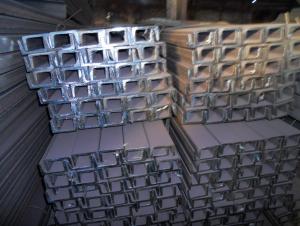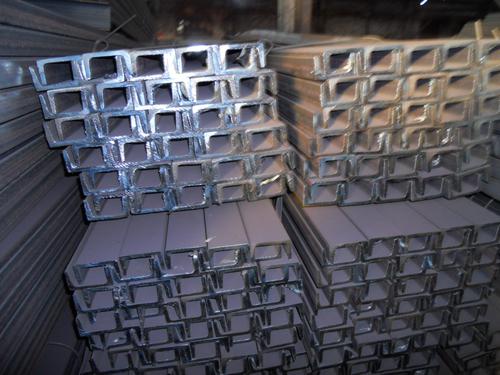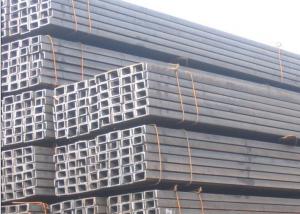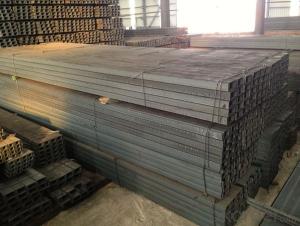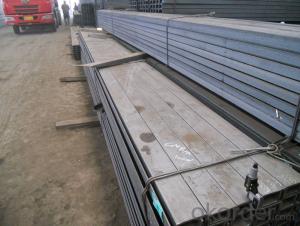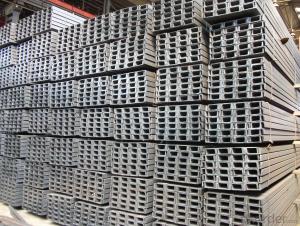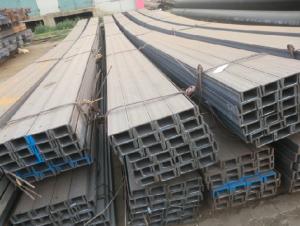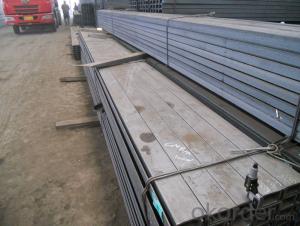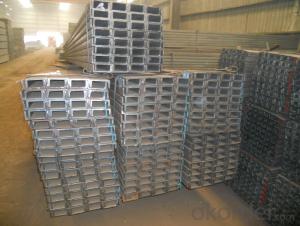14# Steel Channel
- Loading Port:
- China Main Port
- Payment Terms:
- TT OR LC
- Min Order Qty:
- -
- Supply Capability:
- -
OKorder Service Pledge
OKorder Financial Service
You Might Also Like
Steel Channel
Size: 140*58*6*9.5mm
Length: 6m, 12m
Material: GB Q235
1. The chemical composition of HR Channel Steel according to Q235B is shown in Table-1.
Alloy No | Grade | Element(%) | ||||
C | Mn | S | P | Si | ||
Q235 | B | 0.12-0.20 | 0.3-0.7 | ≦0.045 | ≦0.045 | ≦0.3 |
Table-1
Note: we are able to present our customers relevant SGS test report for chemical composition of HR Channel Steel.
2. The mechanical property of HR Channel Steel according to Q235B is shown in Table-2
Alloy No | Grade | Yielding Strength Point(Mpa) | |||
Thickness(mm) | |||||
≦16 | >16-40 | >40-60 | >60-100 | ||
≧ | |||||
Q235 | B | 235 | 225 | 215 | 205 |
Table-2
- Q: How do steel channels perform in high-temperature environments?
- Steel channels perform well in high-temperature environments due to their excellent heat resistance properties. Steel is known for its high melting point and strength, allowing the channels to maintain their structural integrity even under extreme temperatures. Additionally, steel has low thermal expansion, minimizing the risk of warping or distortion. Overall, steel channels are a reliable choice for applications requiring stability and durability in high-temperature settings.
- Q: Are steel channels suitable for supporting overhead equipment or structures?
- Yes, steel channels are suitable for supporting overhead equipment or structures. Steel channels are often used in construction and engineering projects due to their strength and durability. They provide a stable and reliable support system for overhead equipment or structures, ensuring safety and stability. Steel channels are designed to withstand heavy loads, making them ideal for supporting equipment or structures that require a strong and sturdy foundation. Additionally, steel channels can be customized to meet specific project requirements, such as size, shape, and length, further enhancing their suitability for supporting overhead equipment or structures.
- Q: Is the track steel often called channel or construction steel?
- Direct comparison of Wx or Wy, which big will indicate which bending better, more carrying capacity.
- Q: What are the considerations for steel channel connections to steel beams?
- When considering steel channel connections to steel beams, there are several important factors to take into account. First and foremost, it is crucial to ensure that the connection is structurally sound and capable of withstanding the intended loads and forces. This requires a thorough analysis of the design requirements and specifications, including the anticipated loads, the geometry of the channel and beam, and any applicable building codes or regulations. One consideration is the type of connection that will be used. Common options include welding, bolting, or a combination of both. The choice will depend on factors such as the strength requirements, the ease of installation, and any specific constraints or limitations imposed by the project. Another consideration is the connection detailing. This involves determining the specific dimensions, tolerances, and clearances required for the connection to ensure a proper fit and alignment. The detailing should also consider any potential issues that may arise during fabrication, transportation, and erection, such as distortion or misalignment of the components. Furthermore, it is important to consider the potential for corrosion and its impact on the connection. Steel channel connections to steel beams are susceptible to corrosion, especially in environments with high humidity, saltwater exposure, or chemical contaminants. Proper corrosion protection measures, such as coatings, galvanization, or the use of corrosion-resistant materials, should be implemented to ensure the longevity and durability of the connection. Additionally, the connection method should allow for any necessary adjustments or modifications. This is particularly important in cases where the channel may need to be repositioned or replaced in the future. The connection should be designed to allow for easy disconnection, reconnection, or adjustment without compromising the overall structural integrity. Lastly, it is crucial to consider the cost and time implications of the chosen connection method. Different connection methods have varying costs and installation times, and these factors should be weighed against the project budget and schedule. In conclusion, the considerations for steel channel connections to steel beams involve structural integrity, connection type, detailing, corrosion protection, adjustability, and cost/time implications. By carefully addressing these factors, a reliable and efficient connection can be achieved, ensuring the overall stability and strength of the steel structure.
- Q: I think the channel model specifies the standard of cross section, and -39 refers to the length of the channel. Thank you for your answer.
- 39 is certainly not the meaning of specifications and length, may be weight
- Q: Are steel channels suitable for stadium construction?
- Yes, steel channels are suitable for stadium construction. They provide structural stability and strength, making them ideal for supporting heavy loads and withstanding the dynamic forces experienced in a stadium environment. Steel channels also offer flexibility in design, allowing for efficient use of space and the creation of large open spaces. Additionally, steel is a durable and long-lasting material that can withstand harsh weather conditions, making it a reliable choice for stadium construction.
- Q: How are steel channels connected to other structural elements?
- Steel channels can be connected to other structural elements through various methods such as welding, bolting, or using structural connectors. These connections ensure stability and integrity in the overall structure by providing secure attachment points between the steel channels and other components.
- Q: Can steel channels be used in the automotive manufacturing industry?
- Yes, steel channels can be used in the automotive manufacturing industry. Steel channels provide structural support and reinforcement in various components of vehicles, such as chassis, frames, and suspension systems. Their high strength and durability make them suitable for withstanding the rigorous demands of automotive applications.
- Q: Can steel channels be used for conveyor systems?
- Yes, steel channels can be used for conveyor systems. Steel channels offer high strength and durability, making them suitable for supporting heavy loads and resisting wear and tear in conveyor applications.
- Q: Can steel channels be used in framing systems?
- Yes, steel channels can be used in framing systems. Steel channels, also known as C-channels or U-channels, are commonly used in construction and framing applications. They are versatile and provide structural support and stability to the framing system. Steel channels are often used as studs, joists, and beams in both residential and commercial buildings. They offer excellent load-bearing capacity and can withstand heavy loads and forces. Moreover, steel channels are durable, fire-resistant, and resistant to rot, pests, and decay, making them a reliable choice for framing systems.
Send your message to us
14# Steel Channel
- Loading Port:
- China Main Port
- Payment Terms:
- TT OR LC
- Min Order Qty:
- -
- Supply Capability:
- -
OKorder Service Pledge
OKorder Financial Service
Similar products
Hot products
Hot Searches
Related keywords
